BTEC Level 4 HND Marketing Essentials: Ethical Issues and Business
VerifiedAdded on 2021/04/05
|16
|4544
|197
Report
AI Summary
This report, submitted by Cao Ngoc Ngan Thuong, addresses key aspects of marketing essentials within a BTEC Level 4 HND Diploma in Business framework. It begins by defining marketing, its role, and its interrelation with other functional units, highlighting the importance of understanding customer needs and market dynamics. The report details various marketing concepts, including production, product, selling, marketing, and societal concepts, alongside an analysis of the external environment's impact, encompassing social-cultural, economic, technological, demographic, and political factors. It outlines the marketing process, including strategic planning, marketing mix, and the ten steps of strategic marketing planning, emphasizing the importance of market research, SWOT analysis, and budget considerations. The report also discusses the role of the marketing department in organizations, its role in communication, customer relationship management, and promotional activities, emphasizing how it defines an organization's image and fosters long-term customer relationships. The report fulfills the assessment criteria by explaining the roles and responsibilities of marketing, analyzing the marketing environment, and evaluating the key elements of the marketing function and their interrelationships with other organizational units.
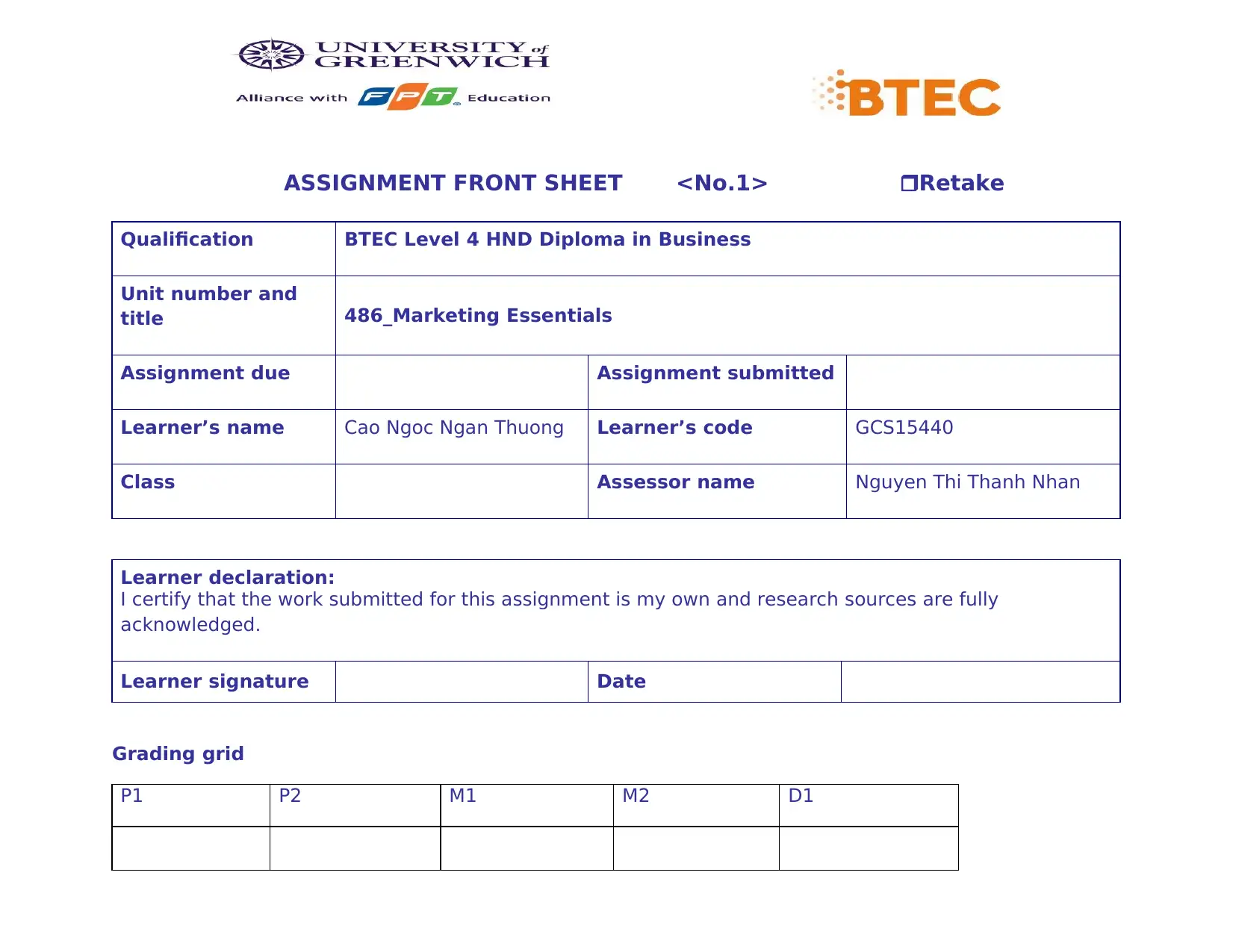
ASSIGNMENT FRONT SHEET <No.1> Retake
Qualification BTEC Level 4 HND Diploma in Business
Unit number and
title 486_Marketing Essentials
Assignment due Assignment submitted
Learner’s name Cao Ngoc Ngan Thuong Learner’s code GCS15440
Class Assessor name Nguyen Thi Thanh Nhan
Learner declaration:
I certify that the work submitted for this assignment is my own and research sources are fully
acknowledged.
Learner signature Date
Grading grid
P1 P2 M1 M2 D1
Qualification BTEC Level 4 HND Diploma in Business
Unit number and
title 486_Marketing Essentials
Assignment due Assignment submitted
Learner’s name Cao Ngoc Ngan Thuong Learner’s code GCS15440
Class Assessor name Nguyen Thi Thanh Nhan
Learner declaration:
I certify that the work submitted for this assignment is my own and research sources are fully
acknowledged.
Learner signature Date
Grading grid
P1 P2 M1 M2 D1
Paraphrase This Document
Need a fresh take? Get an instant paraphrase of this document with our AI Paraphraser
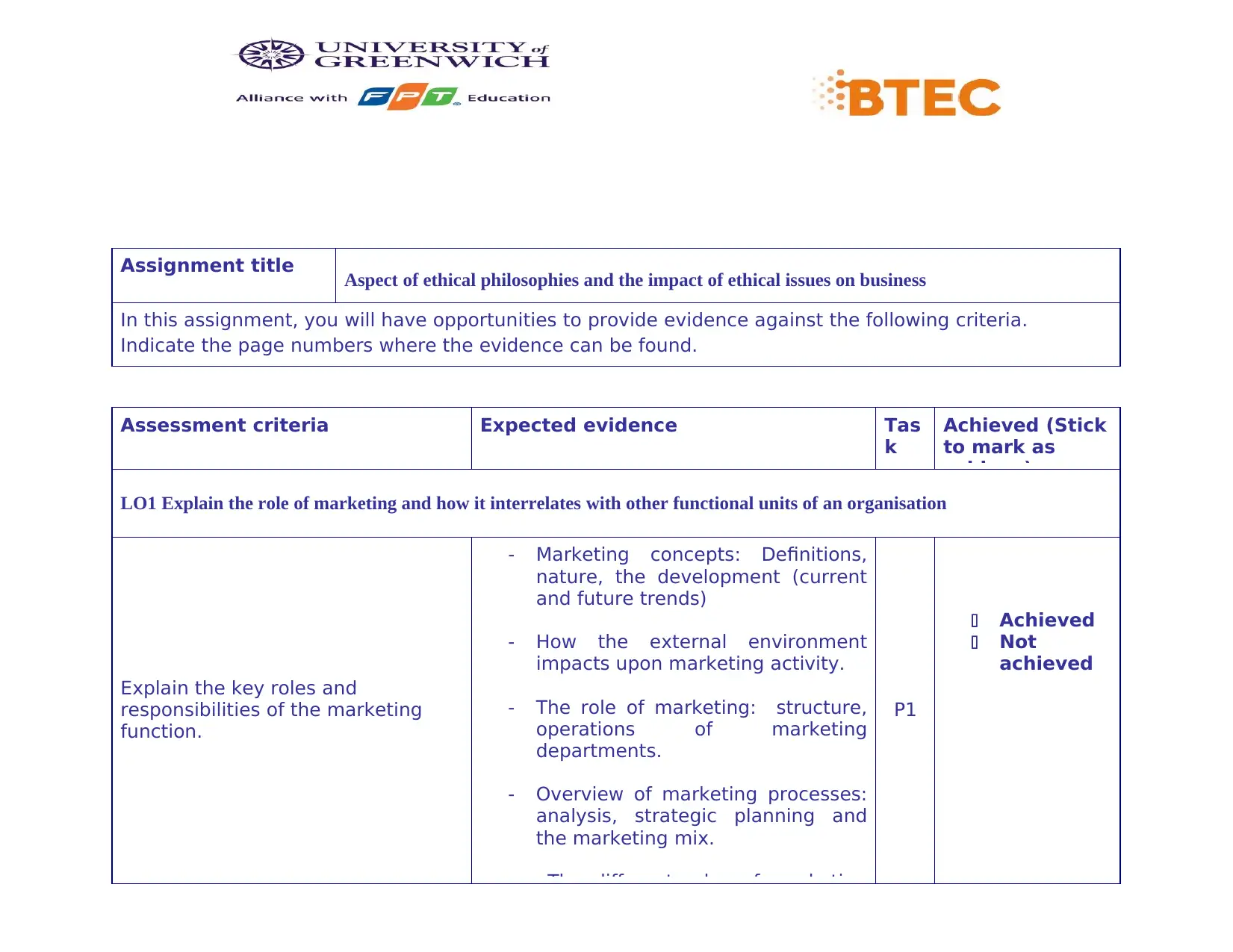
Assignment title Aspect of ethical philosophies and the impact of ethical issues on business
In this assignment, you will have opportunities to provide evidence against the following criteria.
Indicate the page numbers where the evidence can be found.
Assessment criteria Expected evidence Tas
k
no.
Achieved (Stick
to mark as
achieve)
LO1 Explain the role of marketing and how it interrelates with other functional units of an organisation
Explain the key roles and
responsibilities of the marketing
function.
- Marketing concepts: Definitions,
nature, the development (current
and future trends)
- How the external environment
impacts upon marketing activity.
- The role of marketing: structure,
operations of marketing
departments.
- Overview of marketing processes:
analysis, strategic planning and
the marketing mix.
- The different roles of marketing
P1
Achieved
Not
achieved
In this assignment, you will have opportunities to provide evidence against the following criteria.
Indicate the page numbers where the evidence can be found.
Assessment criteria Expected evidence Tas
k
no.
Achieved (Stick
to mark as
achieve)
LO1 Explain the role of marketing and how it interrelates with other functional units of an organisation
Explain the key roles and
responsibilities of the marketing
function.
- Marketing concepts: Definitions,
nature, the development (current
and future trends)
- How the external environment
impacts upon marketing activity.
- The role of marketing: structure,
operations of marketing
departments.
- Overview of marketing processes:
analysis, strategic planning and
the marketing mix.
- The different roles of marketing
P1
Achieved
Not
achieved
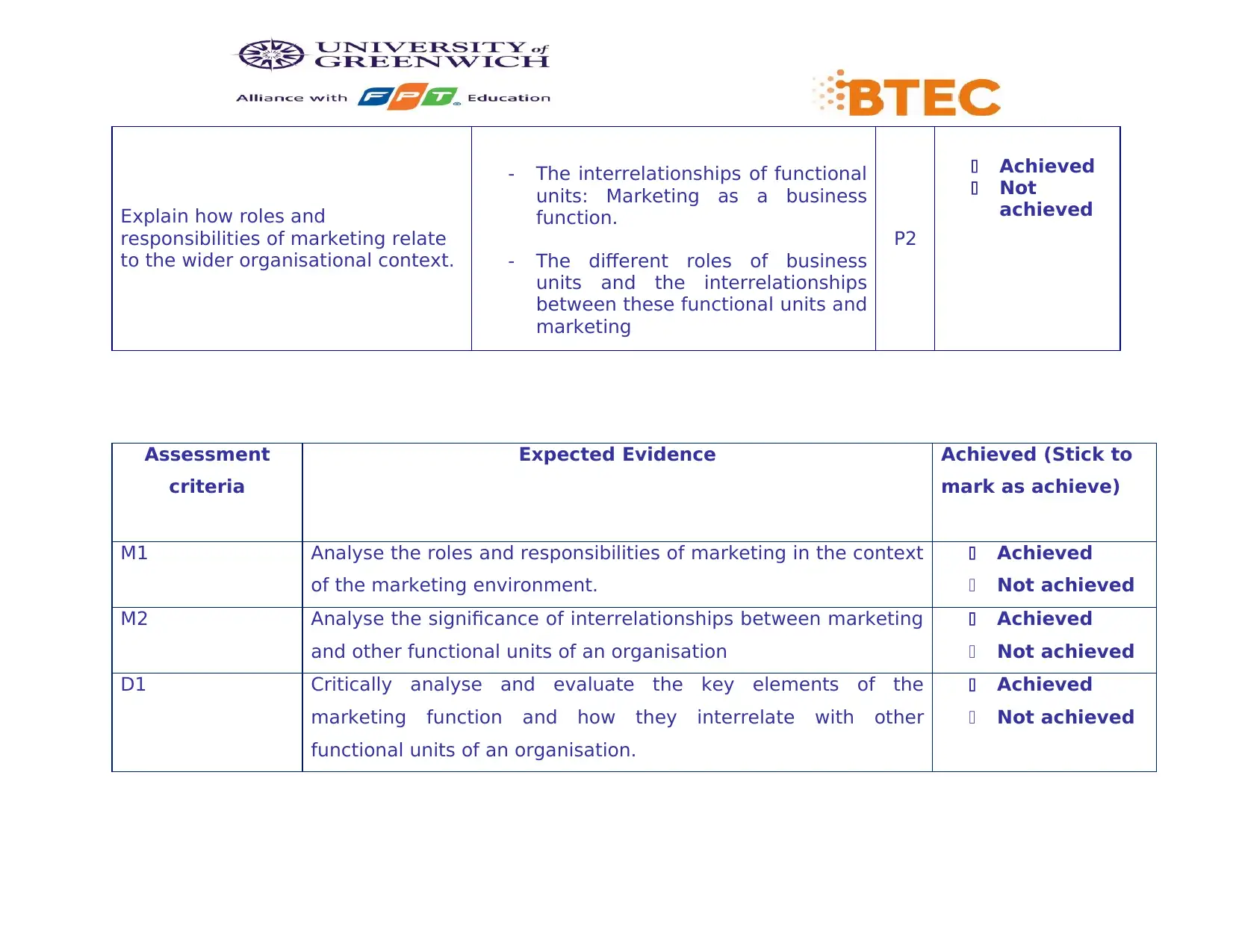
Explain how roles and
responsibilities of marketing relate
to the wider organisational context.
- The interrelationships of functional
units: Marketing as a business
function.
- The different roles of business
units and the interrelationships
between these functional units and
marketing
P2
Achieved
Not
achieved
Assessment
criteria
Expected Evidence Achieved (Stick to
mark as achieve)
M1 Analyse the roles and responsibilities of marketing in the context
of the marketing environment.
Achieved
Not achieved
M2 Analyse the significance of interrelationships between marketing
and other functional units of an organisation
Achieved
Not achieved
D1 Critically analyse and evaluate the key elements of the
marketing function and how they interrelate with other
functional units of an organisation.
Achieved
Not achieved
responsibilities of marketing relate
to the wider organisational context.
- The interrelationships of functional
units: Marketing as a business
function.
- The different roles of business
units and the interrelationships
between these functional units and
marketing
P2
Achieved
Not
achieved
Assessment
criteria
Expected Evidence Achieved (Stick to
mark as achieve)
M1 Analyse the roles and responsibilities of marketing in the context
of the marketing environment.
Achieved
Not achieved
M2 Analyse the significance of interrelationships between marketing
and other functional units of an organisation
Achieved
Not achieved
D1 Critically analyse and evaluate the key elements of the
marketing function and how they interrelate with other
functional units of an organisation.
Achieved
Not achieved
⊘ This is a preview!⊘
Do you want full access?
Subscribe today to unlock all pages.

Trusted by 1+ million students worldwide
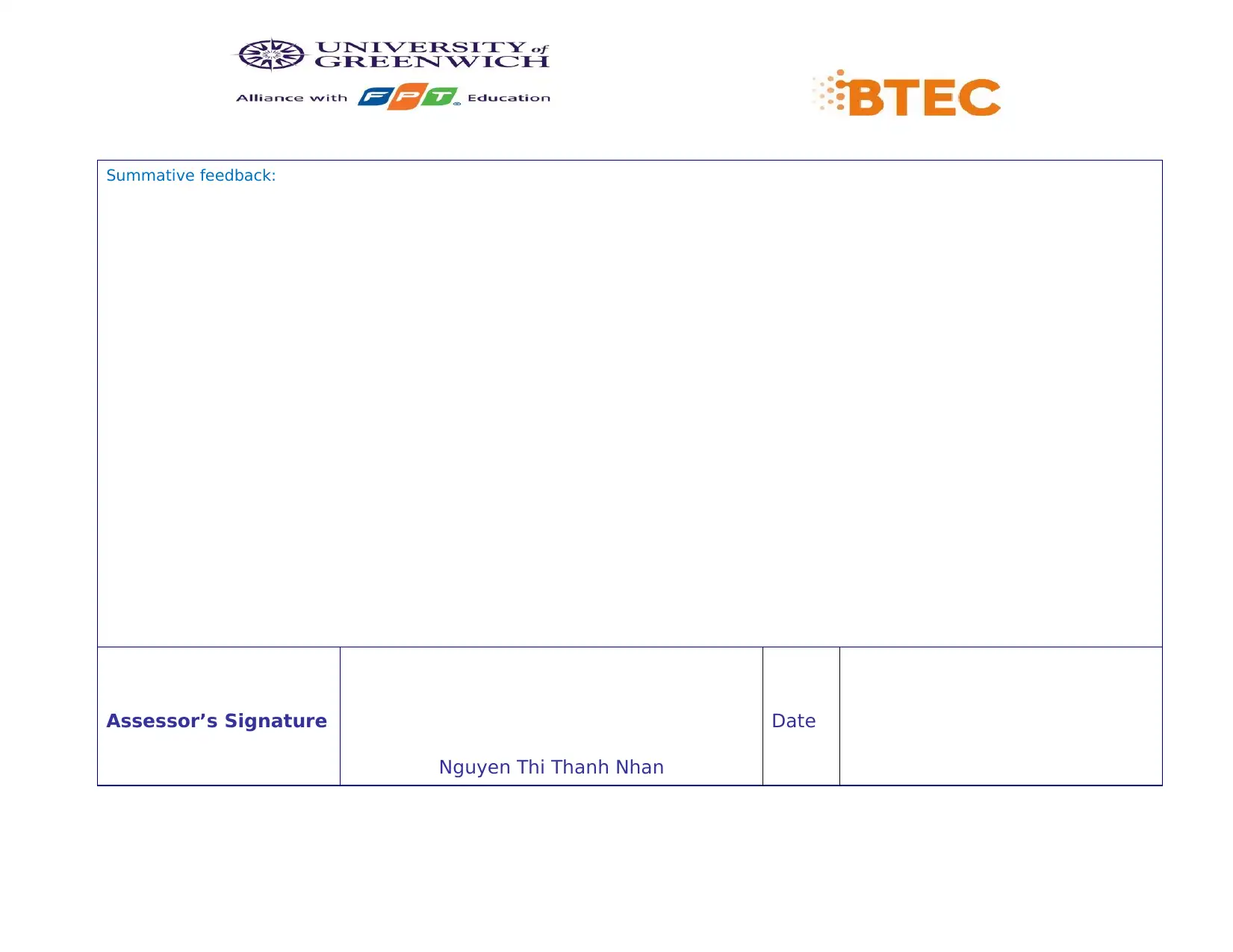
Summative feedback:
Assessor’s Signature
Nguyen Thi Thanh Nhan
Date
Assessor’s Signature
Nguyen Thi Thanh Nhan
Date
Paraphrase This Document
Need a fresh take? Get an instant paraphrase of this document with our AI Paraphraser
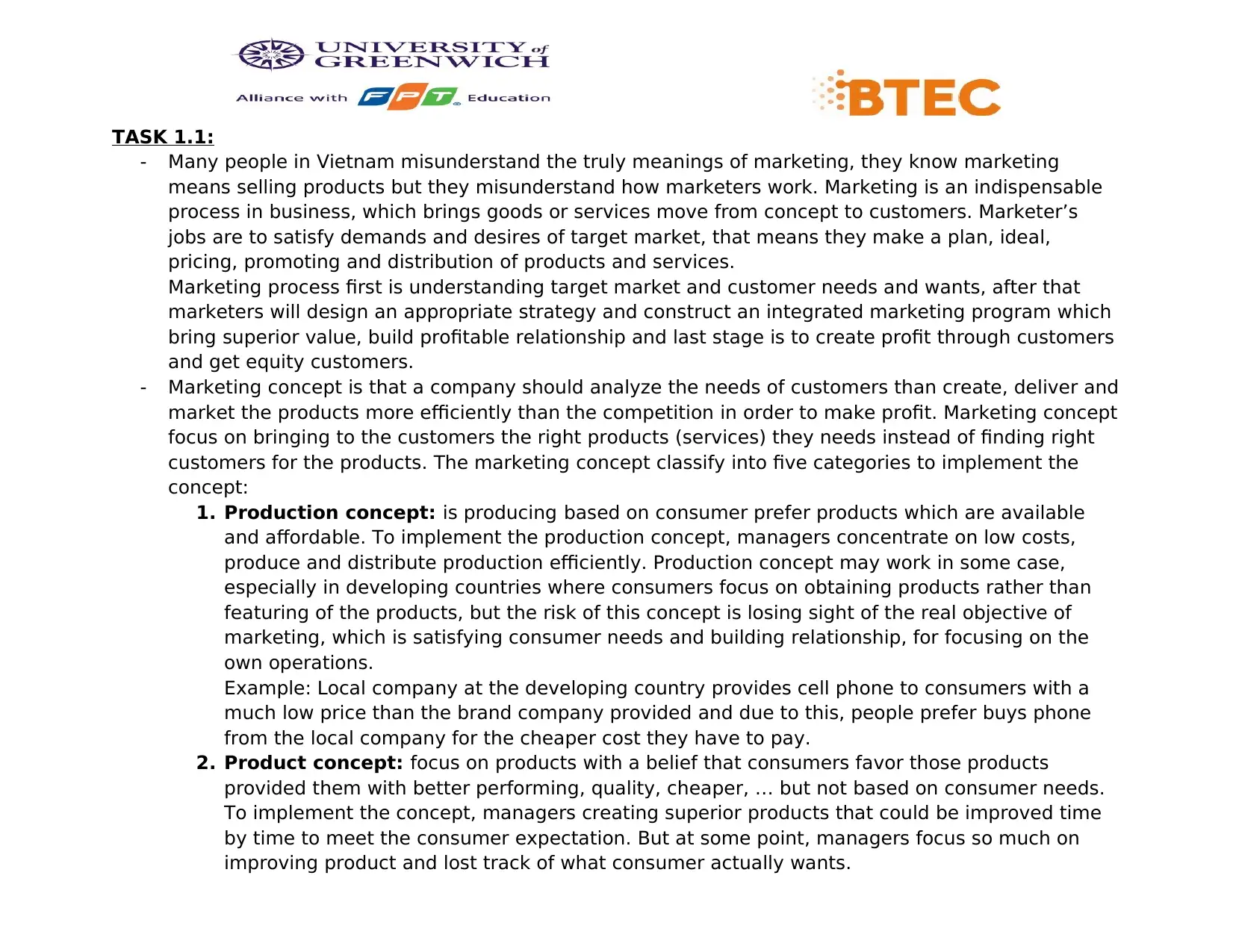
TASK 1.1:
- Many people in Vietnam misunderstand the truly meanings of marketing, they know marketing
means selling products but they misunderstand how marketers work. Marketing is an indispensable
process in business, which brings goods or services move from concept to customers. Marketer’s
jobs are to satisfy demands and desires of target market, that means they make a plan, ideal,
pricing, promoting and distribution of products and services.
Marketing process first is understanding target market and customer needs and wants, after that
marketers will design an appropriate strategy and construct an integrated marketing program which
bring superior value, build profitable relationship and last stage is to create profit through customers
and get equity customers.
- Marketing concept is that a company should analyze the needs of customers than create, deliver and
market the products more efficiently than the competition in order to make profit. Marketing concept
focus on bringing to the customers the right products (services) they needs instead of finding right
customers for the products. The marketing concept classify into five categories to implement the
concept:
1. Production concept: is producing based on consumer prefer products which are available
and affordable. To implement the production concept, managers concentrate on low costs,
produce and distribute production efficiently. Production concept may work in some case,
especially in developing countries where consumers focus on obtaining products rather than
featuring of the products, but the risk of this concept is losing sight of the real objective of
marketing, which is satisfying consumer needs and building relationship, for focusing on the
own operations.
Example: Local company at the developing country provides cell phone to consumers with a
much low price than the brand company provided and due to this, people prefer buys phone
from the local company for the cheaper cost they have to pay.
2. Product concept: focus on products with a belief that consumers favor those products
provided them with better performing, quality, cheaper, … but not based on consumer needs.
To implement the concept, managers creating superior products that could be improved time
by time to meet the consumer expectation. But at some point, managers focus so much on
improving product and lost track of what consumer actually wants.
- Many people in Vietnam misunderstand the truly meanings of marketing, they know marketing
means selling products but they misunderstand how marketers work. Marketing is an indispensable
process in business, which brings goods or services move from concept to customers. Marketer’s
jobs are to satisfy demands and desires of target market, that means they make a plan, ideal,
pricing, promoting and distribution of products and services.
Marketing process first is understanding target market and customer needs and wants, after that
marketers will design an appropriate strategy and construct an integrated marketing program which
bring superior value, build profitable relationship and last stage is to create profit through customers
and get equity customers.
- Marketing concept is that a company should analyze the needs of customers than create, deliver and
market the products more efficiently than the competition in order to make profit. Marketing concept
focus on bringing to the customers the right products (services) they needs instead of finding right
customers for the products. The marketing concept classify into five categories to implement the
concept:
1. Production concept: is producing based on consumer prefer products which are available
and affordable. To implement the production concept, managers concentrate on low costs,
produce and distribute production efficiently. Production concept may work in some case,
especially in developing countries where consumers focus on obtaining products rather than
featuring of the products, but the risk of this concept is losing sight of the real objective of
marketing, which is satisfying consumer needs and building relationship, for focusing on the
own operations.
Example: Local company at the developing country provides cell phone to consumers with a
much low price than the brand company provided and due to this, people prefer buys phone
from the local company for the cheaper cost they have to pay.
2. Product concept: focus on products with a belief that consumers favor those products
provided them with better performing, quality, cheaper, … but not based on consumer needs.
To implement the concept, managers creating superior products that could be improved time
by time to meet the consumer expectation. But at some point, managers focus so much on
improving product and lost track of what consumer actually wants.
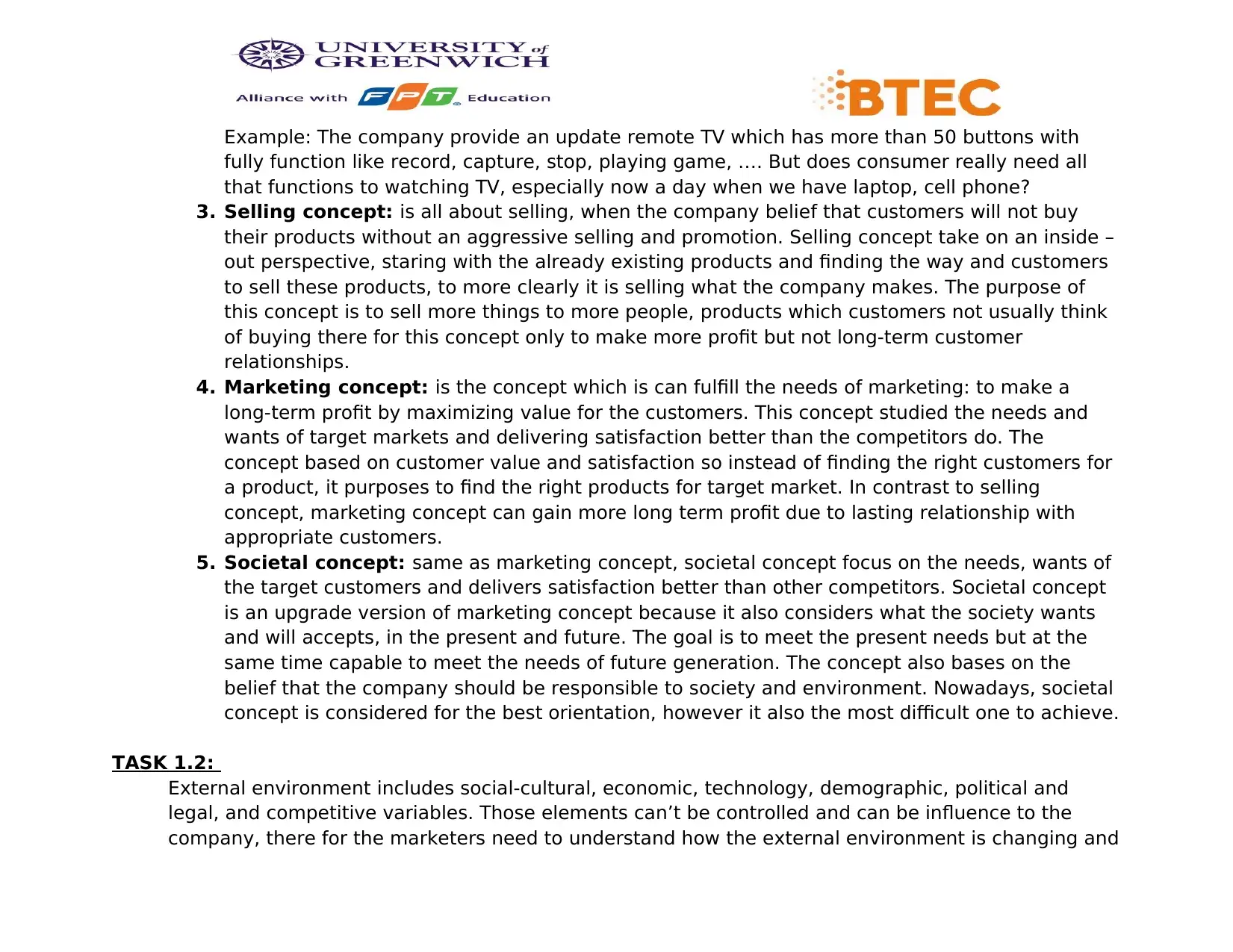
Example: The company provide an update remote TV which has more than 50 buttons with
fully function like record, capture, stop, playing game, …. But does consumer really need all
that functions to watching TV, especially now a day when we have laptop, cell phone?
3. Selling concept: is all about selling, when the company belief that customers will not buy
their products without an aggressive selling and promotion. Selling concept take on an inside –
out perspective, staring with the already existing products and finding the way and customers
to sell these products, to more clearly it is selling what the company makes. The purpose of
this concept is to sell more things to more people, products which customers not usually think
of buying there for this concept only to make more profit but not long-term customer
relationships.
4. Marketing concept: is the concept which is can fulfill the needs of marketing: to make a
long-term profit by maximizing value for the customers. This concept studied the needs and
wants of target markets and delivering satisfaction better than the competitors do. The
concept based on customer value and satisfaction so instead of finding the right customers for
a product, it purposes to find the right products for target market. In contrast to selling
concept, marketing concept can gain more long term profit due to lasting relationship with
appropriate customers.
5. Societal concept: same as marketing concept, societal concept focus on the needs, wants of
the target customers and delivers satisfaction better than other competitors. Societal concept
is an upgrade version of marketing concept because it also considers what the society wants
and will accepts, in the present and future. The goal is to meet the present needs but at the
same time capable to meet the needs of future generation. The concept also bases on the
belief that the company should be responsible to society and environment. Nowadays, societal
concept is considered for the best orientation, however it also the most difficult one to achieve.
TASK 1.2:
External environment includes social-cultural, economic, technology, demographic, political and
legal, and competitive variables. Those elements can’t be controlled and can be influence to the
company, there for the marketers need to understand how the external environment is changing and
fully function like record, capture, stop, playing game, …. But does consumer really need all
that functions to watching TV, especially now a day when we have laptop, cell phone?
3. Selling concept: is all about selling, when the company belief that customers will not buy
their products without an aggressive selling and promotion. Selling concept take on an inside –
out perspective, staring with the already existing products and finding the way and customers
to sell these products, to more clearly it is selling what the company makes. The purpose of
this concept is to sell more things to more people, products which customers not usually think
of buying there for this concept only to make more profit but not long-term customer
relationships.
4. Marketing concept: is the concept which is can fulfill the needs of marketing: to make a
long-term profit by maximizing value for the customers. This concept studied the needs and
wants of target markets and delivering satisfaction better than the competitors do. The
concept based on customer value and satisfaction so instead of finding the right customers for
a product, it purposes to find the right products for target market. In contrast to selling
concept, marketing concept can gain more long term profit due to lasting relationship with
appropriate customers.
5. Societal concept: same as marketing concept, societal concept focus on the needs, wants of
the target customers and delivers satisfaction better than other competitors. Societal concept
is an upgrade version of marketing concept because it also considers what the society wants
and will accepts, in the present and future. The goal is to meet the present needs but at the
same time capable to meet the needs of future generation. The concept also bases on the
belief that the company should be responsible to society and environment. Nowadays, societal
concept is considered for the best orientation, however it also the most difficult one to achieve.
TASK 1.2:
External environment includes social-cultural, economic, technology, demographic, political and
legal, and competitive variables. Those elements can’t be controlled and can be influence to the
company, there for the marketers need to understand how the external environment is changing and
⊘ This is a preview!⊘
Do you want full access?
Subscribe today to unlock all pages.

Trusted by 1+ million students worldwide
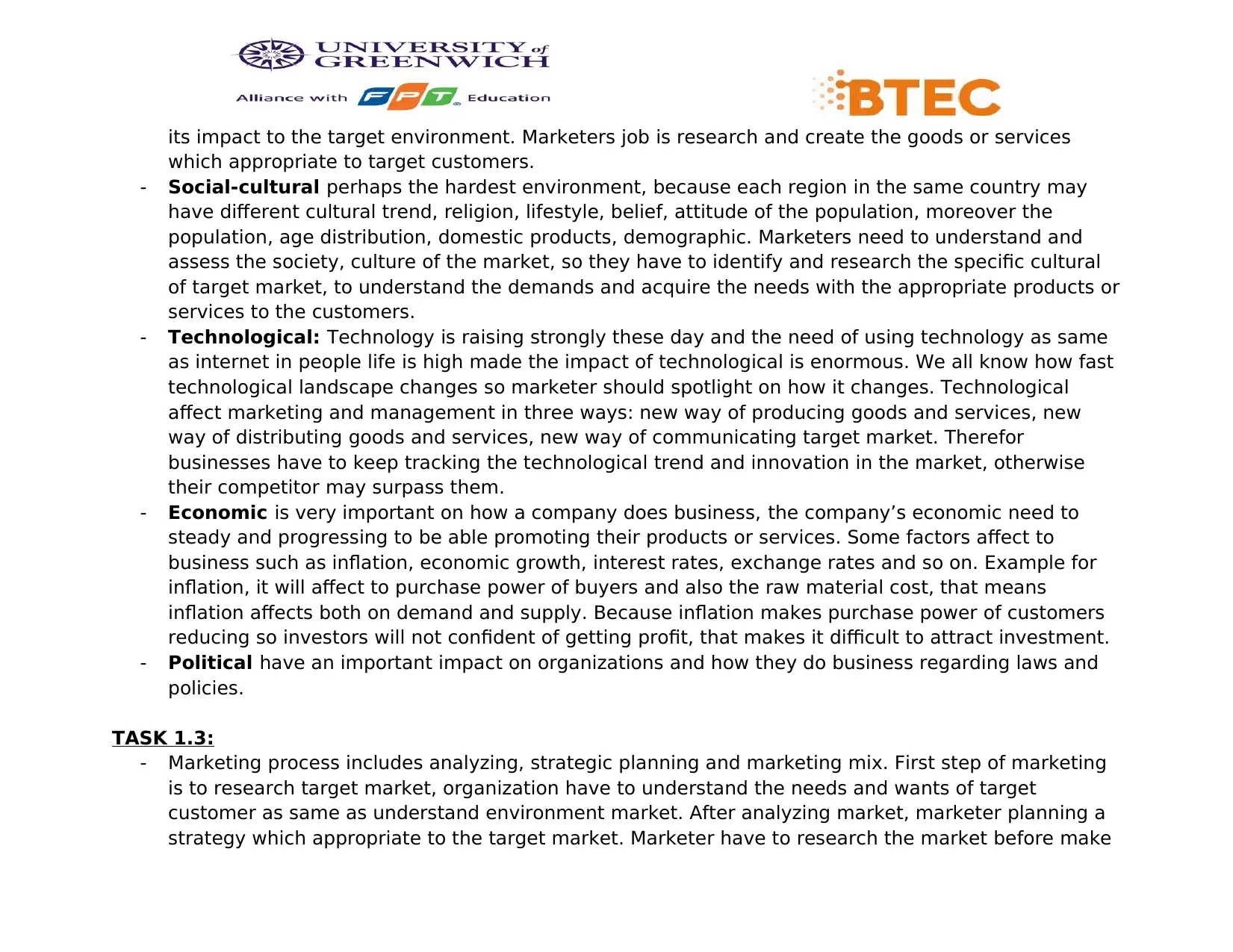
its impact to the target environment. Marketers job is research and create the goods or services
which appropriate to target customers.
- Social-cultural perhaps the hardest environment, because each region in the same country may
have different cultural trend, religion, lifestyle, belief, attitude of the population, moreover the
population, age distribution, domestic products, demographic. Marketers need to understand and
assess the society, culture of the market, so they have to identify and research the specific cultural
of target market, to understand the demands and acquire the needs with the appropriate products or
services to the customers.
- Technological: Technology is raising strongly these day and the need of using technology as same
as internet in people life is high made the impact of technological is enormous. We all know how fast
technological landscape changes so marketer should spotlight on how it changes. Technological
affect marketing and management in three ways: new way of producing goods and services, new
way of distributing goods and services, new way of communicating target market. Therefor
businesses have to keep tracking the technological trend and innovation in the market, otherwise
their competitor may surpass them.
- Economic is very important on how a company does business, the company’s economic need to
steady and progressing to be able promoting their products or services. Some factors affect to
business such as inflation, economic growth, interest rates, exchange rates and so on. Example for
inflation, it will affect to purchase power of buyers and also the raw material cost, that means
inflation affects both on demand and supply. Because inflation makes purchase power of customers
reducing so investors will not confident of getting profit, that makes it difficult to attract investment.
- Political have an important impact on organizations and how they do business regarding laws and
policies.
TASK 1.3:
- Marketing process includes analyzing, strategic planning and marketing mix. First step of marketing
is to research target market, organization have to understand the needs and wants of target
customer as same as understand environment market. After analyzing market, marketer planning a
strategy which appropriate to the target market. Marketer have to research the market before make
which appropriate to target customers.
- Social-cultural perhaps the hardest environment, because each region in the same country may
have different cultural trend, religion, lifestyle, belief, attitude of the population, moreover the
population, age distribution, domestic products, demographic. Marketers need to understand and
assess the society, culture of the market, so they have to identify and research the specific cultural
of target market, to understand the demands and acquire the needs with the appropriate products or
services to the customers.
- Technological: Technology is raising strongly these day and the need of using technology as same
as internet in people life is high made the impact of technological is enormous. We all know how fast
technological landscape changes so marketer should spotlight on how it changes. Technological
affect marketing and management in three ways: new way of producing goods and services, new
way of distributing goods and services, new way of communicating target market. Therefor
businesses have to keep tracking the technological trend and innovation in the market, otherwise
their competitor may surpass them.
- Economic is very important on how a company does business, the company’s economic need to
steady and progressing to be able promoting their products or services. Some factors affect to
business such as inflation, economic growth, interest rates, exchange rates and so on. Example for
inflation, it will affect to purchase power of buyers and also the raw material cost, that means
inflation affects both on demand and supply. Because inflation makes purchase power of customers
reducing so investors will not confident of getting profit, that makes it difficult to attract investment.
- Political have an important impact on organizations and how they do business regarding laws and
policies.
TASK 1.3:
- Marketing process includes analyzing, strategic planning and marketing mix. First step of marketing
is to research target market, organization have to understand the needs and wants of target
customer as same as understand environment market. After analyzing market, marketer planning a
strategy which appropriate to the target market. Marketer have to research the market before make
Paraphrase This Document
Need a fresh take? Get an instant paraphrase of this document with our AI Paraphraser
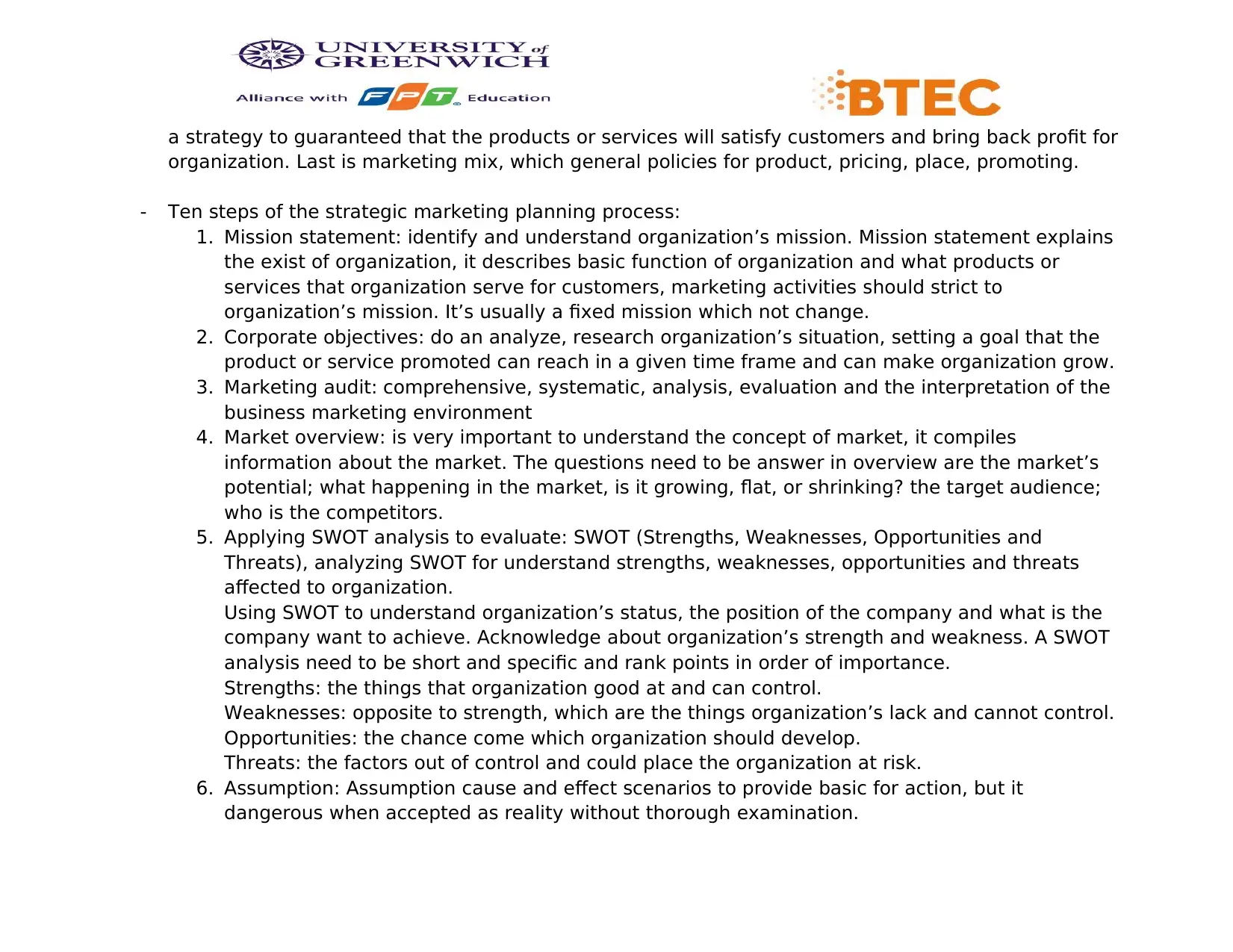
a strategy to guaranteed that the products or services will satisfy customers and bring back profit for
organization. Last is marketing mix, which general policies for product, pricing, place, promoting.
- Ten steps of the strategic marketing planning process:
1. Mission statement: identify and understand organization’s mission. Mission statement explains
the exist of organization, it describes basic function of organization and what products or
services that organization serve for customers, marketing activities should strict to
organization’s mission. It’s usually a fixed mission which not change.
2. Corporate objectives: do an analyze, research organization’s situation, setting a goal that the
product or service promoted can reach in a given time frame and can make organization grow.
3. Marketing audit: comprehensive, systematic, analysis, evaluation and the interpretation of the
business marketing environment
4. Market overview: is very important to understand the concept of market, it compiles
information about the market. The questions need to be answer in overview are the market’s
potential; what happening in the market, is it growing, flat, or shrinking? the target audience;
who is the competitors.
5. Applying SWOT analysis to evaluate: SWOT (Strengths, Weaknesses, Opportunities and
Threats), analyzing SWOT for understand strengths, weaknesses, opportunities and threats
affected to organization.
Using SWOT to understand organization’s status, the position of the company and what is the
company want to achieve. Acknowledge about organization’s strength and weakness. A SWOT
analysis need to be short and specific and rank points in order of importance.
Strengths: the things that organization good at and can control.
Weaknesses: opposite to strength, which are the things organization’s lack and cannot control.
Opportunities: the chance come which organization should develop.
Threats: the factors out of control and could place the organization at risk.
6. Assumption: Assumption cause and effect scenarios to provide basic for action, but it
dangerous when accepted as reality without thorough examination.
organization. Last is marketing mix, which general policies for product, pricing, place, promoting.
- Ten steps of the strategic marketing planning process:
1. Mission statement: identify and understand organization’s mission. Mission statement explains
the exist of organization, it describes basic function of organization and what products or
services that organization serve for customers, marketing activities should strict to
organization’s mission. It’s usually a fixed mission which not change.
2. Corporate objectives: do an analyze, research organization’s situation, setting a goal that the
product or service promoted can reach in a given time frame and can make organization grow.
3. Marketing audit: comprehensive, systematic, analysis, evaluation and the interpretation of the
business marketing environment
4. Market overview: is very important to understand the concept of market, it compiles
information about the market. The questions need to be answer in overview are the market’s
potential; what happening in the market, is it growing, flat, or shrinking? the target audience;
who is the competitors.
5. Applying SWOT analysis to evaluate: SWOT (Strengths, Weaknesses, Opportunities and
Threats), analyzing SWOT for understand strengths, weaknesses, opportunities and threats
affected to organization.
Using SWOT to understand organization’s status, the position of the company and what is the
company want to achieve. Acknowledge about organization’s strength and weakness. A SWOT
analysis need to be short and specific and rank points in order of importance.
Strengths: the things that organization good at and can control.
Weaknesses: opposite to strength, which are the things organization’s lack and cannot control.
Opportunities: the chance come which organization should develop.
Threats: the factors out of control and could place the organization at risk.
6. Assumption: Assumption cause and effect scenarios to provide basic for action, but it
dangerous when accepted as reality without thorough examination.
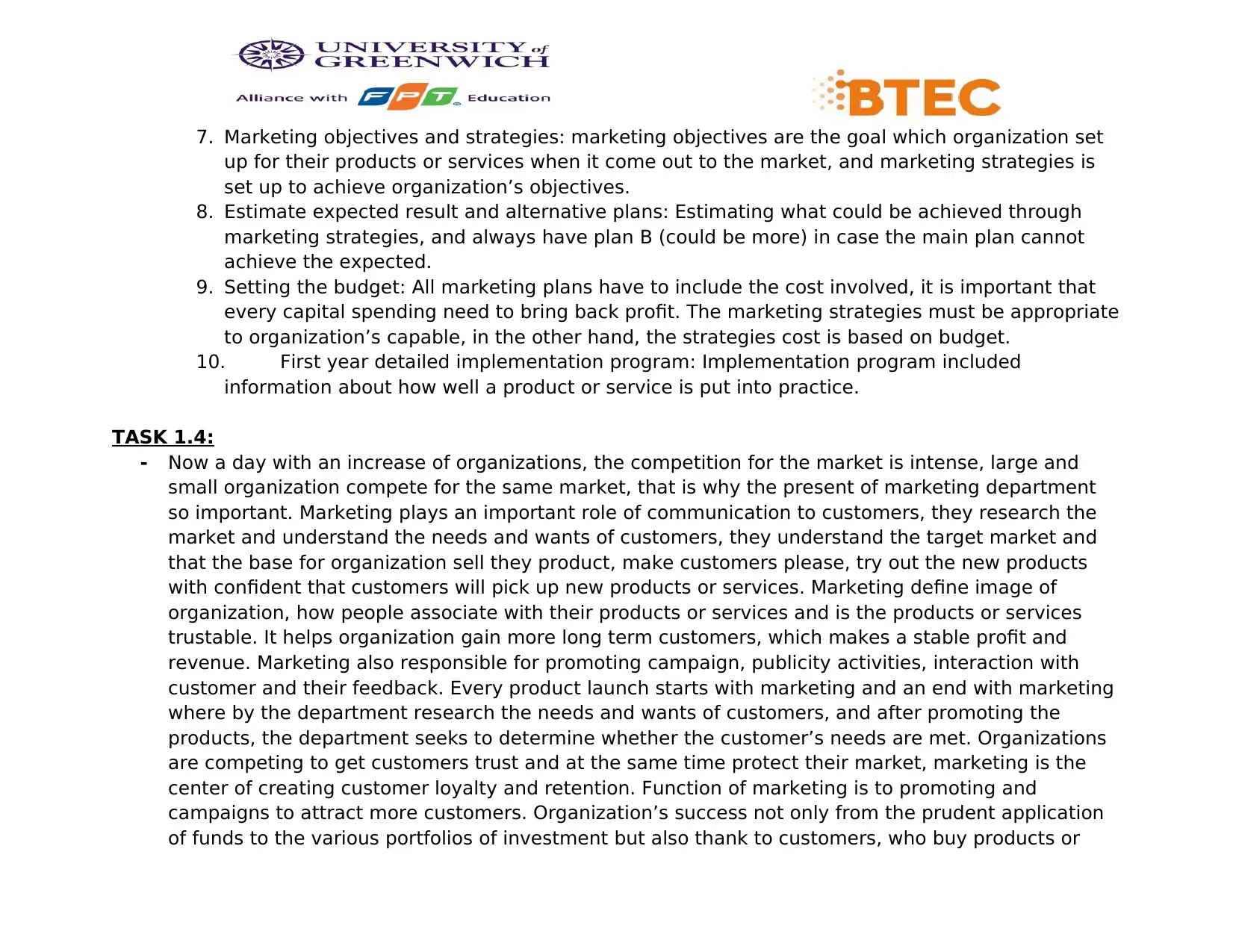
7. Marketing objectives and strategies: marketing objectives are the goal which organization set
up for their products or services when it come out to the market, and marketing strategies is
set up to achieve organization’s objectives.
8. Estimate expected result and alternative plans: Estimating what could be achieved through
marketing strategies, and always have plan B (could be more) in case the main plan cannot
achieve the expected.
9. Setting the budget: All marketing plans have to include the cost involved, it is important that
every capital spending need to bring back profit. The marketing strategies must be appropriate
to organization’s capable, in the other hand, the strategies cost is based on budget.
10. First year detailed implementation program: Implementation program included
information about how well a product or service is put into practice.
TASK 1.4:
- Now a day with an increase of organizations, the competition for the market is intense, large and
small organization compete for the same market, that is why the present of marketing department
so important. Marketing plays an important role of communication to customers, they research the
market and understand the needs and wants of customers, they understand the target market and
that the base for organization sell they product, make customers please, try out the new products
with confident that customers will pick up new products or services. Marketing define image of
organization, how people associate with their products or services and is the products or services
trustable. It helps organization gain more long term customers, which makes a stable profit and
revenue. Marketing also responsible for promoting campaign, publicity activities, interaction with
customer and their feedback. Every product launch starts with marketing and an end with marketing
where by the department research the needs and wants of customers, and after promoting the
products, the department seeks to determine whether the customer’s needs are met. Organizations
are competing to get customers trust and at the same time protect their market, marketing is the
center of creating customer loyalty and retention. Function of marketing is to promoting and
campaigns to attract more customers. Organization’s success not only from the prudent application
of funds to the various portfolios of investment but also thank to customers, who buy products or
up for their products or services when it come out to the market, and marketing strategies is
set up to achieve organization’s objectives.
8. Estimate expected result and alternative plans: Estimating what could be achieved through
marketing strategies, and always have plan B (could be more) in case the main plan cannot
achieve the expected.
9. Setting the budget: All marketing plans have to include the cost involved, it is important that
every capital spending need to bring back profit. The marketing strategies must be appropriate
to organization’s capable, in the other hand, the strategies cost is based on budget.
10. First year detailed implementation program: Implementation program included
information about how well a product or service is put into practice.
TASK 1.4:
- Now a day with an increase of organizations, the competition for the market is intense, large and
small organization compete for the same market, that is why the present of marketing department
so important. Marketing plays an important role of communication to customers, they research the
market and understand the needs and wants of customers, they understand the target market and
that the base for organization sell they product, make customers please, try out the new products
with confident that customers will pick up new products or services. Marketing define image of
organization, how people associate with their products or services and is the products or services
trustable. It helps organization gain more long term customers, which makes a stable profit and
revenue. Marketing also responsible for promoting campaign, publicity activities, interaction with
customer and their feedback. Every product launch starts with marketing and an end with marketing
where by the department research the needs and wants of customers, and after promoting the
products, the department seeks to determine whether the customer’s needs are met. Organizations
are competing to get customers trust and at the same time protect their market, marketing is the
center of creating customer loyalty and retention. Function of marketing is to promoting and
campaigns to attract more customers. Organization’s success not only from the prudent application
of funds to the various portfolios of investment but also thank to customers, who buy products or
⊘ This is a preview!⊘
Do you want full access?
Subscribe today to unlock all pages.

Trusted by 1+ million students worldwide
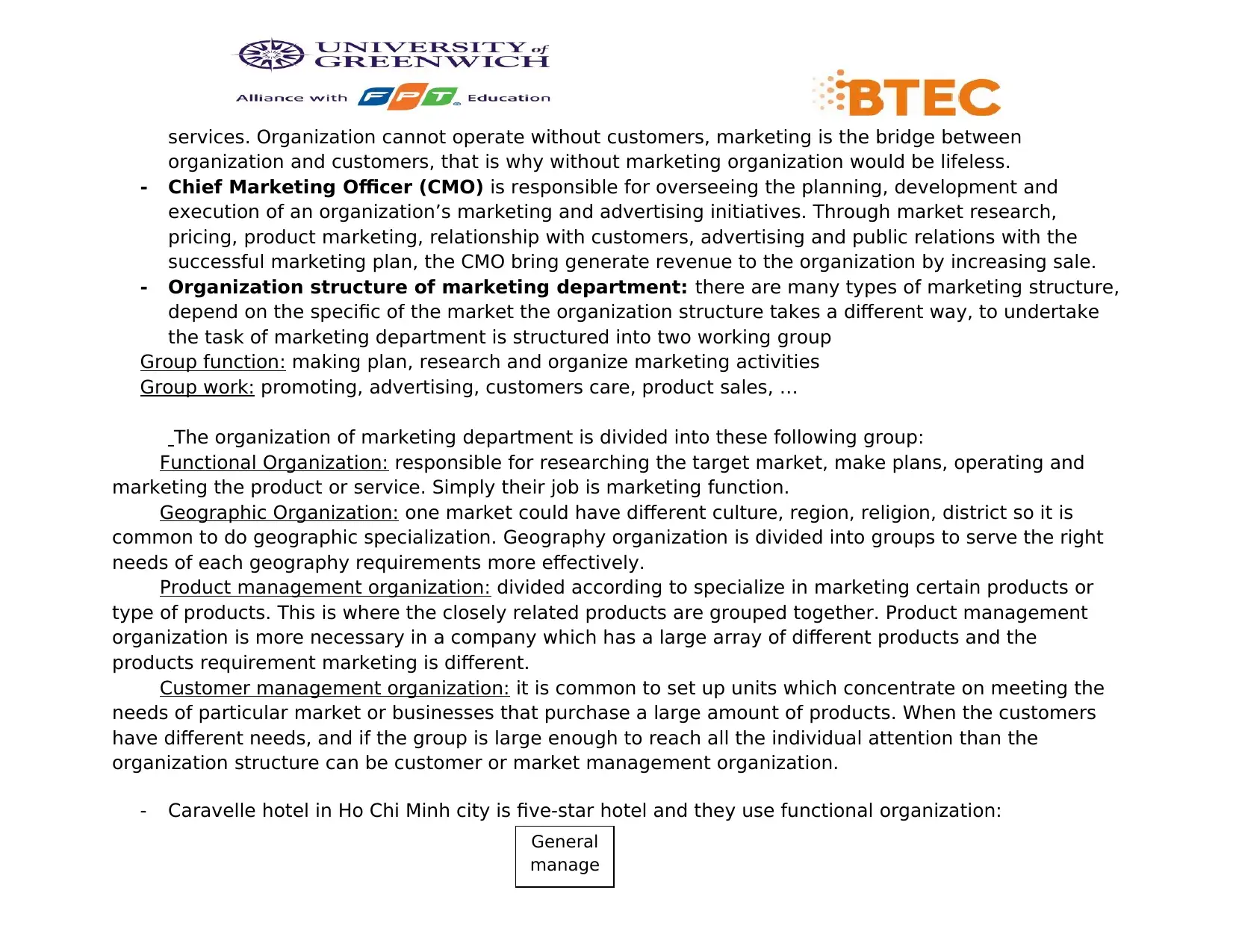
services. Organization cannot operate without customers, marketing is the bridge between
organization and customers, that is why without marketing organization would be lifeless.
- Chief Marketing Officer (CMO) is responsible for overseeing the planning, development and
execution of an organization’s marketing and advertising initiatives. Through market research,
pricing, product marketing, relationship with customers, advertising and public relations with the
successful marketing plan, the CMO bring generate revenue to the organization by increasing sale.
- Organization structure of marketing department: there are many types of marketing structure,
depend on the specific of the market the organization structure takes a different way, to undertake
the task of marketing department is structured into two working group
Group function: making plan, research and organize marketing activities
Group work: promoting, advertising, customers care, product sales, …
The organization of marketing department is divided into these following group:
Functional Organization: responsible for researching the target market, make plans, operating and
marketing the product or service. Simply their job is marketing function.
Geographic Organization: one market could have different culture, region, religion, district so it is
common to do geographic specialization. Geography organization is divided into groups to serve the right
needs of each geography requirements more effectively.
Product management organization: divided according to specialize in marketing certain products or
type of products. This is where the closely related products are grouped together. Product management
organization is more necessary in a company which has a large array of different products and the
products requirement marketing is different.
Customer management organization: it is common to set up units which concentrate on meeting the
needs of particular market or businesses that purchase a large amount of products. When the customers
have different needs, and if the group is large enough to reach all the individual attention than the
organization structure can be customer or market management organization.
- Caravelle hotel in Ho Chi Minh city is five-star hotel and they use functional organization:
General
manage
r
organization and customers, that is why without marketing organization would be lifeless.
- Chief Marketing Officer (CMO) is responsible for overseeing the planning, development and
execution of an organization’s marketing and advertising initiatives. Through market research,
pricing, product marketing, relationship with customers, advertising and public relations with the
successful marketing plan, the CMO bring generate revenue to the organization by increasing sale.
- Organization structure of marketing department: there are many types of marketing structure,
depend on the specific of the market the organization structure takes a different way, to undertake
the task of marketing department is structured into two working group
Group function: making plan, research and organize marketing activities
Group work: promoting, advertising, customers care, product sales, …
The organization of marketing department is divided into these following group:
Functional Organization: responsible for researching the target market, make plans, operating and
marketing the product or service. Simply their job is marketing function.
Geographic Organization: one market could have different culture, region, religion, district so it is
common to do geographic specialization. Geography organization is divided into groups to serve the right
needs of each geography requirements more effectively.
Product management organization: divided according to specialize in marketing certain products or
type of products. This is where the closely related products are grouped together. Product management
organization is more necessary in a company which has a large array of different products and the
products requirement marketing is different.
Customer management organization: it is common to set up units which concentrate on meeting the
needs of particular market or businesses that purchase a large amount of products. When the customers
have different needs, and if the group is large enough to reach all the individual attention than the
organization structure can be customer or market management organization.
- Caravelle hotel in Ho Chi Minh city is five-star hotel and they use functional organization:
General
manage
r
Paraphrase This Document
Need a fresh take? Get an instant paraphrase of this document with our AI Paraphraser
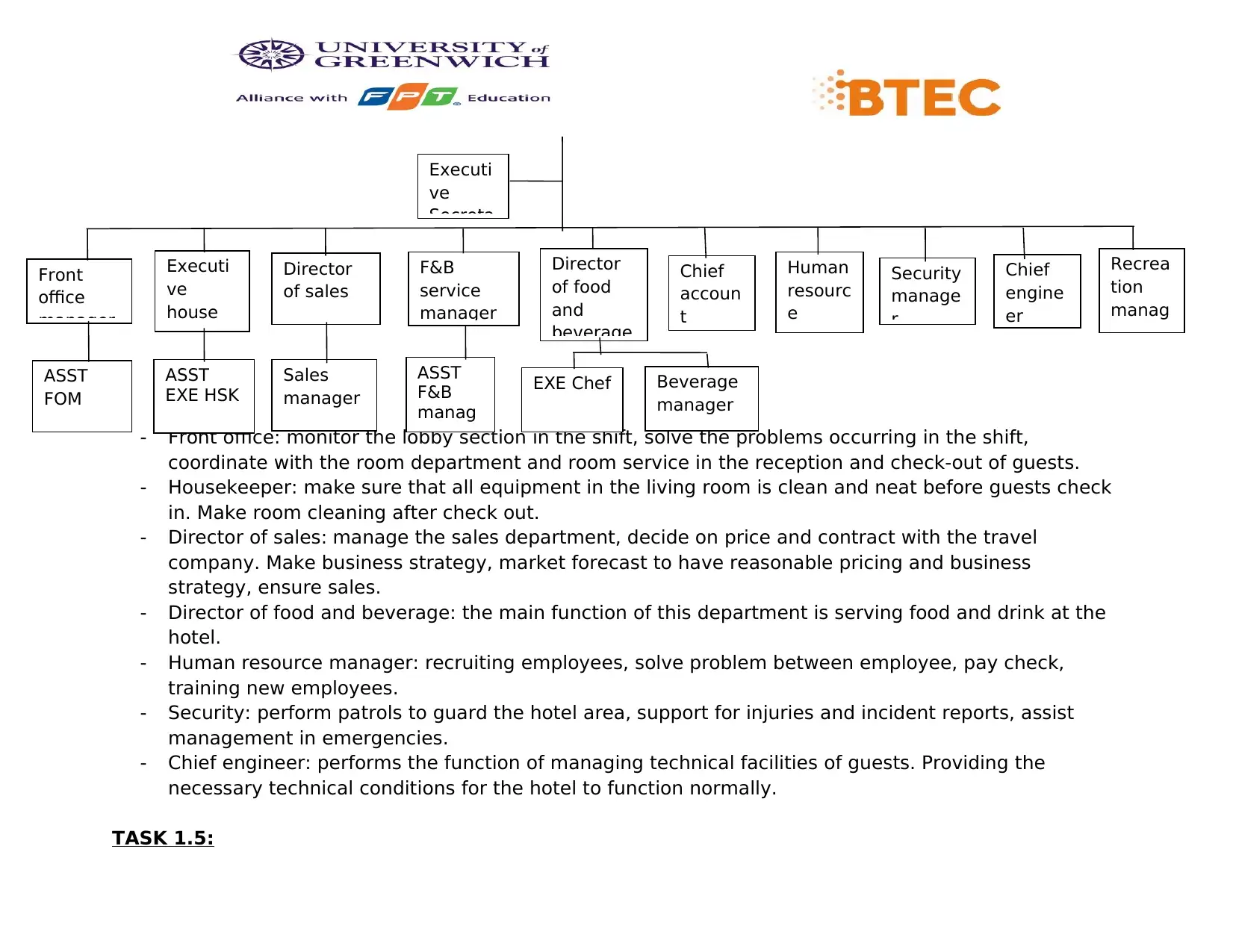
- Front office: monitor the lobby section in the shift, solve the problems occurring in the shift,
coordinate with the room department and room service in the reception and check-out of guests.
- Housekeeper: make sure that all equipment in the living room is clean and neat before guests check
in. Make room cleaning after check out.
- Director of sales: manage the sales department, decide on price and contract with the travel
company. Make business strategy, market forecast to have reasonable pricing and business
strategy, ensure sales.
- Director of food and beverage: the main function of this department is serving food and drink at the
hotel.
- Human resource manager: recruiting employees, solve problem between employee, pay check,
training new employees.
- Security: perform patrols to guard the hotel area, support for injuries and incident reports, assist
management in emergencies.
- Chief engineer: performs the function of managing technical facilities of guests. Providing the
necessary technical conditions for the hotel to function normally.
TASK 1.5:
Executi
ve
Secreta
Recrea
tion
manag
er
Director
of food
and
beverage
Executi
ve
house
keeper
Front
office
manager
Security
manage
r
Chief
engine
er
Human
resourc
e
manag
Chief
accoun
t
F&B
service
manager
Director
of sales
ASST
FOM Beverage
manager
EXE Chef
ASST
F&B
manag
er
Sales
manager
ASST
EXE HSK
coordinate with the room department and room service in the reception and check-out of guests.
- Housekeeper: make sure that all equipment in the living room is clean and neat before guests check
in. Make room cleaning after check out.
- Director of sales: manage the sales department, decide on price and contract with the travel
company. Make business strategy, market forecast to have reasonable pricing and business
strategy, ensure sales.
- Director of food and beverage: the main function of this department is serving food and drink at the
hotel.
- Human resource manager: recruiting employees, solve problem between employee, pay check,
training new employees.
- Security: perform patrols to guard the hotel area, support for injuries and incident reports, assist
management in emergencies.
- Chief engineer: performs the function of managing technical facilities of guests. Providing the
necessary technical conditions for the hotel to function normally.
TASK 1.5:
Executi
ve
Secreta
Recrea
tion
manag
er
Director
of food
and
beverage
Executi
ve
house
keeper
Front
office
manager
Security
manage
r
Chief
engine
er
Human
resourc
e
manag
Chief
accoun
t
F&B
service
manager
Director
of sales
ASST
FOM Beverage
manager
EXE Chef
ASST
F&B
manag
er
Sales
manager
ASST
EXE HSK
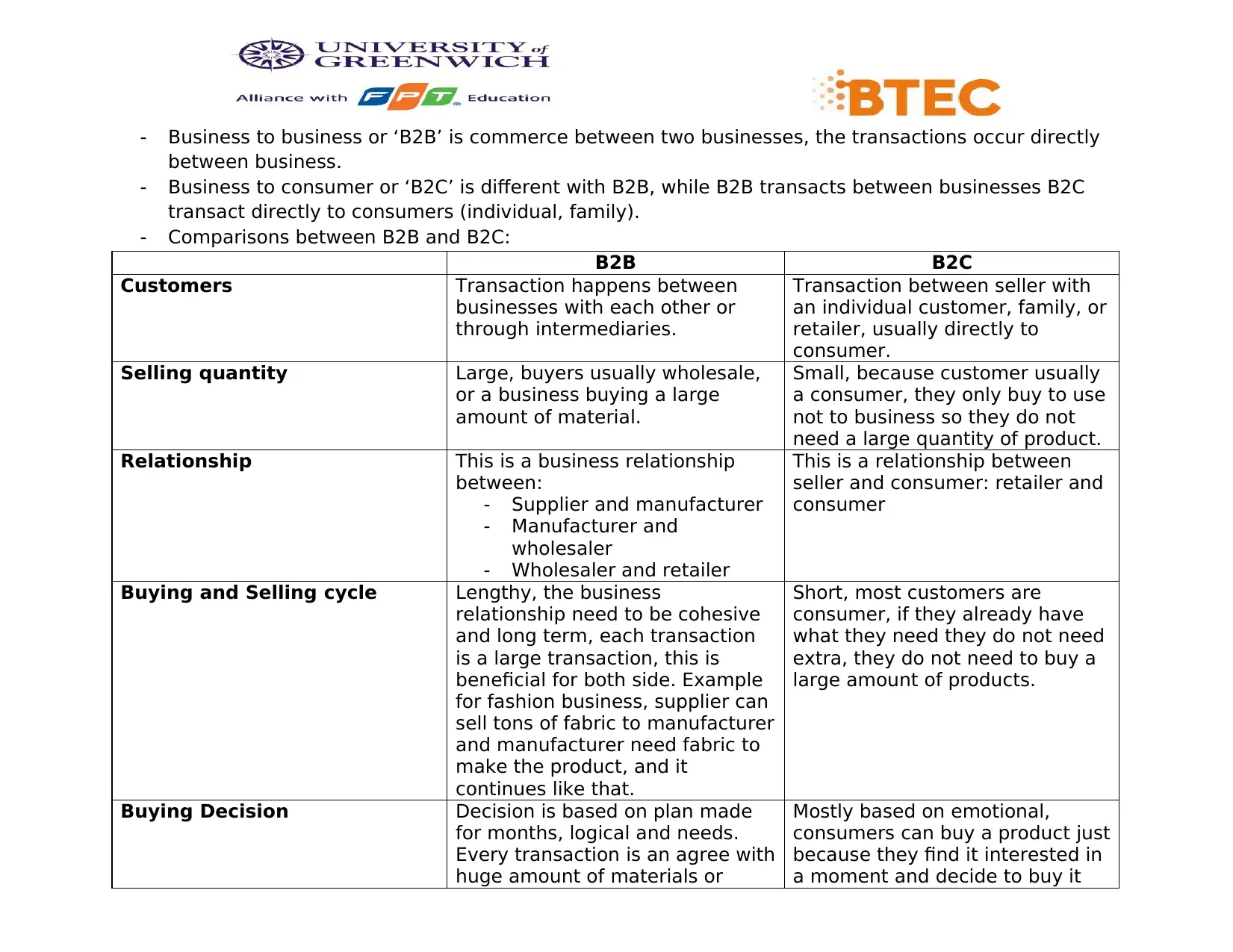
- Business to business or ‘B2B’ is commerce between two businesses, the transactions occur directly
between business.
- Business to consumer or ‘B2C’ is different with B2B, while B2B transacts between businesses B2C
transact directly to consumers (individual, family).
- Comparisons between B2B and B2C:
B2B B2C
Customers Transaction happens between
businesses with each other or
through intermediaries.
Transaction between seller with
an individual customer, family, or
retailer, usually directly to
consumer.
Selling quantity Large, buyers usually wholesale,
or a business buying a large
amount of material.
Small, because customer usually
a consumer, they only buy to use
not to business so they do not
need a large quantity of product.
Relationship This is a business relationship
between:
- Supplier and manufacturer
- Manufacturer and
wholesaler
- Wholesaler and retailer
This is a relationship between
seller and consumer: retailer and
consumer
Buying and Selling cycle Lengthy, the business
relationship need to be cohesive
and long term, each transaction
is a large transaction, this is
beneficial for both side. Example
for fashion business, supplier can
sell tons of fabric to manufacturer
and manufacturer need fabric to
make the product, and it
continues like that.
Short, most customers are
consumer, if they already have
what they need they do not need
extra, they do not need to buy a
large amount of products.
Buying Decision Decision is based on plan made
for months, logical and needs.
Every transaction is an agree with
huge amount of materials or
Mostly based on emotional,
consumers can buy a product just
because they find it interested in
a moment and decide to buy it
between business.
- Business to consumer or ‘B2C’ is different with B2B, while B2B transacts between businesses B2C
transact directly to consumers (individual, family).
- Comparisons between B2B and B2C:
B2B B2C
Customers Transaction happens between
businesses with each other or
through intermediaries.
Transaction between seller with
an individual customer, family, or
retailer, usually directly to
consumer.
Selling quantity Large, buyers usually wholesale,
or a business buying a large
amount of material.
Small, because customer usually
a consumer, they only buy to use
not to business so they do not
need a large quantity of product.
Relationship This is a business relationship
between:
- Supplier and manufacturer
- Manufacturer and
wholesaler
- Wholesaler and retailer
This is a relationship between
seller and consumer: retailer and
consumer
Buying and Selling cycle Lengthy, the business
relationship need to be cohesive
and long term, each transaction
is a large transaction, this is
beneficial for both side. Example
for fashion business, supplier can
sell tons of fabric to manufacturer
and manufacturer need fabric to
make the product, and it
continues like that.
Short, most customers are
consumer, if they already have
what they need they do not need
extra, they do not need to buy a
large amount of products.
Buying Decision Decision is based on plan made
for months, logical and needs.
Every transaction is an agree with
huge amount of materials or
Mostly based on emotional,
consumers can buy a product just
because they find it interested in
a moment and decide to buy it
⊘ This is a preview!⊘
Do you want full access?
Subscribe today to unlock all pages.

Trusted by 1+ million students worldwide
1 out of 16
Related Documents
Your All-in-One AI-Powered Toolkit for Academic Success.
+13062052269
info@desklib.com
Available 24*7 on WhatsApp / Email
![[object Object]](/_next/static/media/star-bottom.7253800d.svg)
Unlock your academic potential
Copyright © 2020–2025 A2Z Services. All Rights Reserved. Developed and managed by ZUCOL.





